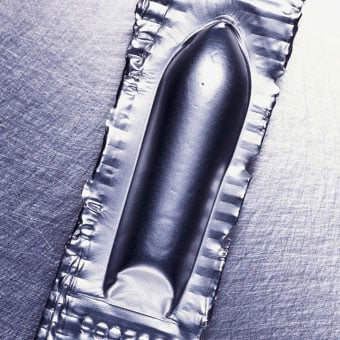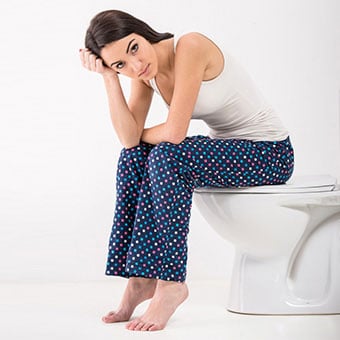Constipation
- Definition
- Symptoms & Signs
- Chronic Constipation
- Causes
- Diagnosis
- Treatment
- Remedies
- Foods
- Laxatives
What facts should l know about constipation?
What is the medical definition of constipation?
Constipation is defined medically as fewer than three stools per week and severe constipation is less than one stool per week. Some of the symptoms of constipation include lower abdominal discomfort, a sense of incomplete evacuation (the feeling that you still have to "go") after a bowel movement, straining to have a bowel movement, hard or small stools, rectal bleeding, and/or anal fissures caused by hard stools, physiological distress and/or obsession with having bowel movements.
What causes constipation?
Constipation usually is caused by the slow movement of material through the colon (large bowel). Two disorders that cause constipation are
- colonic inertia, and
- pelvic floor dysfunction.
There are many causes of and associations with constipation, for example, medications; poor bowel habits; low fiber diets; possibly abuse of laxatives; hormonal disorders; diseases primarily of other parts of the body that also affect the colon; and high levels of estrogen and progesterone during pregnancy.
What are the signs and symptoms of constipation?
Signs and symptoms of constipation may include rectal bleeding and/or anal fissures that are caused by hard or small stools, lower abdominal discomfort, and straining to have a bowel movement.
Call your doctor or other health care professional for treatment for constipation if you have a sudden onset of symptoms that come on suddenly that are severe pain that worsens and are associated with other worrisome symptoms such as suddenly losing weight, or is not responding to simple, safe and effective treatments.
What exams, tests, and procedures cause constipation?
Tests to diagnose the cause of constipation may include a medical history, physical examination, blood tests, abdominal X-rays, barium enema, colonic transit studies, defecography, anorectal motility studies, and colonic motility studies.
What are the goals for constipation therapy? Is there a special diet plan for it? How is it cured?
The goal of therapy for constipation is one bowel movement every two to three days without straining. Treatment may include foods high in fiber, non-stimulant laxatives, stimulant laxatives, enemas, suppositories, biofeedback training, prescription medications, and surgery. Stimulant laxatives, including herbal products, should be used as a last resort because they might damage the colon and worsen constipation.

What is constipation?
Constipation means different things to different people. For many people, it simply means infrequent passage of stool (feces). For others, however, it means hard stools, difficulty passing them (straining), or a sense of incomplete emptying after a bowel movement. The cause of each of these symptoms of constipation vary, so the approach to each should be tailored to each specific patient.
Constipation also can alternate with diarrhea. This pattern commonly occurs as part of the irritable bowel syndrome (IBS). At the extreme end of the spectrum for it is fecal impaction, which is when the stool hardens in the rectum and prevents passage (although occasionally diarrhea may occur even with obstruction due to colonic fluid leaking around the impacted stool).
The number of bowel movements generally decreases with age. Most adults have what is considered normal, between three and 21 times per week. The most common pattern is one bowel movement a day, but this pattern is seen in less than half of individuals. Moreover, most are irregular and don't have bowel movements every day or the same number every day.
Medically speaking, constipation usually is defined as fewer than three bowel movements per week. Severe constipation is defined as less than one bowel movement per week. There is no medical reason to have one bowel movement every day. Going without one for two or three days does not cause physical discomfort, only mental distress (in some people). Contrary to popular belief, there is no evidence that "toxins" accumulate when movements are infrequent or that constipation leads to cancer.
It is important to distinguish acute (recent onset) constipation from chronic (long duration) constipation. Acute constipation requires urgent assessment because a serious medical illness may be the underlying cause (for example, tumors of the colon). It also requires an immediate assessment if it is accompanied by symptoms such as rectal bleeding, abdominal pain and cramps, nausea and vomiting, and involuntary loss of weight. The evaluation of chronic constipation may not be urgent, particularly if simple measures bring relief.
What are constipation symptoms and signs?
Signs and symptoms of constipation include
- infrequent bowel movements,
- straining when going to the bathroom,
- hard and/or small feces,
- a sense of incomplete evacuation after going to the bathroom,
- lower abdominal discomfort,
- abdominal bloating,
- occasionally distension (bloating),
- anal bleeding or fissures from the trauma caused by hard feces,
- occasionally diarrhea due to obstruction of the colon by hard stool,
- rarely,
- colonic perforation,
- psychological distress and/or obsession with having to go to the bathroom, and possible aggravation of the diverticular disease,
- hemorrhoids, and
- rectal prolapse.
When should I seek medical care for chronic constipation?
If the main problem is straining to push the stool out, chronic constipation should probably be evaluated early. This difficulty might be due to pelvic floor dysfunction, and the treatment of choice is biofeedback training, not laxatives. If it is not responding to the simple measures discussed previously with the addition of hyperosmolar products or milk of magnesia, it is time to consult a physician for an evaluation. If a primary doctor is not comfortable performing the evaluation or does not have confidence in doing an evaluation, he or she should refer the patient to a gastroenterologist. Gastroenterologists evaluate constipation frequently and are very familiar with the diagnostic testing described previously.
What causes constipation?
Theoretically, constipation can be caused by the slow passage of digesting food through any part of the digestive system. Most of the time, however, the slowing occurs in the colon
What medications cause constipation?
Medications are frequently overlooked as a cause of constipation. Common medications that cause constipation include narcotic pain medications, for example, codeine (for example, (Tylenol #3), oxycodone (for example, Percocet) and hydromorphone (Dilaudid), antidepressants such as amitriptyline (Elavil, Endep) and imipramine (Tofranil), anticonvulsants, for example phenytoin (Dilantin) and carbamazepine (Tegretol), iron supplements, calcium channel blocking drugs (CCBs), for example, diltiazem (Cardizem) and nifedipine (Procardia). Aluminum-containing antacids such as aluminum hydroxide suspension (Amphojel) and aluminum carbonate (Basaljel)
Many other drugs can cause constipation. Simple measures can be used to treat constipation, for example, increasing fiber in your diet or taking stool softeners. If constipation is caused by a medication, talk to your doctor about discontinuing medications that may not be not necessary. If simple measures don't work, it may be possible to substitute a less constipating medication, for example, a nonsteroidal ant-inflammatory drug (NSAIDs), for example, ibuprofen (Advil, Motrin, Nuprin) and naproxen (Aleve, Anaprox, Naprelan, and Naprosyn), or one of the newer and less constipating antidepressants.

What are other causes of constipation?
Habit: Bowel movements are under voluntary control. This means that the normal urge you feel when you need to have one can be suppressed. Although occasionally it is appropriate to suppress an urge to defecate (for example, when a bathroom is not available), doing this too frequently can lead to a disappearance of urges and result in constipation.
Diet: Fiber is important in maintaining a soft, bulky stool. Therefore, eating foods low in fiber can cause constipation. The best natural sources of fiber are fruits, vegetables, and whole grains.
Laxatives: One suspected cause of severe constipation is the over-use of stimulant laxatives, for example, senna (Senokot), castor oil, and many herbs. An association has been shown between the chronic use of these products and damage to the nerves and muscles of the colon, possibly resulting in the condition. It is not clear, however, whether the products have caused the damage or whether the damage existed prior to the use them. Nevertheless, because of the possibility that stimulant products can damage the colon, most experts recommend that they be used as a last resort after non-stimulant products have failed.
Hormonal disorders: Hormones can affect bowel movements. For example, too little thyroid hormone (hypothyroidism) and too much parathyroid hormone (by raising the calcium levels in the blood). At the time of a woman's menstrual periods, estrogen and progesterone levels are high. However, this is rarely a prolonged condition. High levels of estrogen and progesterone during pregnancy also cause constipation.
What exams, procedures, and tests help diagnose the cause of severe constipation?
Medical history
Many tests can diagnose severe constipation, and most people only need a few basic tests. First the doctor or health care professional will take a medical history and physical examination to allow the doctor to define the type of constipation that's present; uncover any supplements or prescription products you are taking; or diseases or other health problems you have. This, in turn, directs the diagnosis and therapy. For example, if defecation is painful, the doctor knows to look for anal problems such as a narrowed anal sphincter or an anal fissure. If small stools are the problem, eating foods low in fiber may be the cause. If the patient is experiencing significant straining, then pelvic floor dysfunction is likely.
A careful dietary history-which may require keeping a food diary for a week or two-can reveal a diet that is low in fiber and may direct the physician to recommend a high-fiber diet. A food diary also allows the physician to evaluate how well an individual increases his dietary fiber during treatment.
Other tests are available for people who have severe constipation that doesn't respond easily to treatment.
Physical examination
A physical examination may identify diseases (for example, scleroderma) that can cause constipation. A rectal examination with the finger may uncover a tight anal sphincter that may be making defecation difficult or it may find that the muscles of the pelvic floor do not relax normally. If a material-filled colon can be felt through the abdominal wall, it suggests that it is severe. Stool in the rectum suggests a problem with the anal, rectal, or pelvic floor muscles.
Blood tests
Blood tests may be appropriate in evaluating your condition. More specifically, blood tests for thyroid hormone (to detect hypothyroidism) and for calcium (to uncover excess parathyroid hormone) may be helpful.
Abdominal X-ray
Large amounts of material in the colon usually can be visualized on simple X-ray films of the abdomen, and the more severe constipation, the more visualized on X-ray.
Barium enema
A barium enema (lower gastrointestinal [GI] series) is an X-ray study in which liquid barium is inserted through the anus to fill the rectum and colon. The barium outlines the colon on the X-rays and defines the normal or abnormal anatomy of the bowel and rectum. Tumors and narrowings (strictures) are among the abnormalities that can be detected with this test.
Colonic transit (marker) studies
Colonic transit studies are simple X-ray studies that determine how long it takes for food to travel through the intestines. For transit studies, individuals swallow capsules for one or more days. Inside the capsules are many small pieces of plastic that can be seen on X-rays. The gelatin capsules dissolve and release the plastic pieces into the small intestine. The pieces of plastic then travel (as would digesting food) through the small intestine and into the bowel. After 5 or 7 days, an X-ray of the abdomen is taken and the pieces of plastic in the different parts of the bowel are counted. From this count, it is possible to determine if and where there is a delay in the colon.
In people who are not constipated, all of the plastic pieces are eliminated in the feces and none remain in the colon. When pieces are spread throughout the colon, it suggests that the muscles or nerves throughout the colon are not working, which is typical of colonic inertia. When pieces accumulate in the rectum, it suggests pelvic floor dysfunction.
Defecography
Defecography is a modification of the barium enema examination. For this procedure, a thick paste of barium is inserted into the rectum of a patient through the anus. X-rays then are taken while the patient defecates the barium. The barium clearly outlines the rectum and anus and demonstrates the changes taking place in the muscles of the pelvic floor during defecation. Thus, defecography examines the process of defecation and provides information about anatomical abnormalities of the rectum and pelvic floor muscles during defecation.
Anorectal motility studies
Anorectal motility studies, which complement defecography tests, provide an assessment of the function of the muscles and nerves of the anus and rectum. For anorectal motility studies, a flexible tube, approximately an eighth of an inch in diameter, is inserted through the anus and into the rectum. Sensors within the tube measure the pressures that are generated by the muscles of the anus and rectum. With the tube in place, the individual performs several simple maneuvers such as voluntarily tightening the anal muscles. Anorectal motility studies can help determine if the muscles of the anus and rectum are working normally. When the function of these muscles is impaired, the flow of material through the GI tracts is obstructed, thereby causing a condition similar to pelvic floor dysfunction.
Magnetic resonance imaging defecography
The newest test for evaluating defecation and its disorders is magnetic resonance imaging (MRI) defecography and is similar to barium defecography. However, MRI is used instead of X-rays to provide images of the rectum during defecation. MRI defecography appears to be an excellent way to study defecation, but the procedure is expensive and somewhat cumbersome. As a result, it is used in only a few institutions that have a particular interest in constipation and abnormalities of defecation.
Colonic motility studies
Colonic motility studies are similar to anorectal motility studies in many aspects. A very long, narrow (one-eighth inch in diameter), flexible tube is inserted through the anus and passed through part or the entire colon during a procedure called colonoscopy. Sensors within the tube measure the pressures that are generated by the contractions of the colonic muscles. These contractions are the result of coordinated activity of the colonic nerves and muscles. If the activity of the nerves or muscles is abnormal, the pattern of colonic pressures will be abnormal. Colonic motility studies are most useful in defining colonic inertia. These studies are considered research tools, but they can help make decisions regarding treatment in individuals with severe constipation.
What are treatments for the causes of constipation?
There are several principles in approaching the evaluation and treatment of constipation. The first principle is to differentiate between acute (recent onset) and chronic (long duration) constipation. Thus, with acute constipation or constipation that is worsening, it is necessary to assess for the cause early so as not to overlook a serious illness that should be treated urgently. 2) start treatment early of constipation and use the treatments that have the least potential for harm, which will prevent constipation from worsening, and it will prevent potential damage to the colon that can be caused by the frequent use of stimulant products. 3) know when it is time to evaluate the cause of chronic constipation. Evaluation for the cause of chronic constipation needs to be done if there is no response to the simple treatments.
What natural or home remedies relieve and treat constipation?
Natural and home remedies to relieve pain and stop constipation?
Don't suppress urges to defecate. When the urge comes, find a toilet. With the assistance of your doctor and pharmacist, determine if there are drugs that you are taking that could be contributing to constipation. See if the drugs can be discontinued or changed.
Increase the fiber in your diet by consuming more fruits, vegetables, and whole grains. (There are other health benefits from this recommendation as well.) It may be difficult to get enough fiber in the diet to effectively treat constipation, so don't hesitate to take fiber supplements if necessary (wheat bran, psyllium, etc.). Use increasing amounts of fiber and/or change the type of fiber consumed until there is a satisfactory result. Don't expect fiber to work overnight. Allow a few weeks for adequate trials.
What if constipation does not respond to natural and home remedies?
These efforts should not be discontinued but other measures should be added. If it is infrequent, that is, every few weeks (as it can be when due to the menstrual cycle), it probably doesn't matter what other measures are added-emollient, saline, or hyperosmolar laxatives, enemas, and suppositories. Even stimulant laxatives every four to six weeks are unlikely to damage the colon. Unfortunately, the tendency when using stimulant products is to unconsciously increase the frequency of their use. Before you know it, you're taking them every week, or more often, and there is a concern (though no proof) that permanent colonic damage might result.
If constipation is a continuous rather than an intermittent problem, probably the safest products to take on a regular basis are the hyperosmolar laxatives. Their use should be supervised by a physician. As with fiber, increasing doses of different hyperosmolar products should be tried over several weeks until a satisfactory type and dose of laxative is found. Hyperosmolar laxatives, however, can be expensive. Milk of magnesia is the mildest of the saline laxatives, is inexpensive, and provides a good alternative. Most patients can adjust the dose of milk of magnesia to soften the stool adequately without developing diarrhea or leakage of stool.
Prunes and prune juice have been used for many years to treat mild constipation. There is no evidence that the mild stimulant effects of prunes or prune juice damage the colon.
Stronger stimulant products usually are recommended only as a last resort after non-stimulant treatments have failed. Many people take herbs to treat the problem because they feel more comfortable using a "natural" product. Unfortunately, most of these herbal preparations contain stimulant products and their long-term use raises the possibility that they also may damage the colon.
What kind of high-fiber diet treats constipation?
The best way of adding fiber to the diet is increasing the quantity of fruits and vegetables that are eaten. This means a minimum of five servings of fruits or vegetables every day. For many people, however, the amount of fruits and vegetables that are necessary may be inconveniently large or may not provide adequate relief from the condition. In this case, fiber supplements can be useful.
Fiber is defined as material made by plants that is not digested by the human gastrointestinal tract. It is one of the mainstays in the treatment. Many types of fiber within the intestine bind to water and keep the water within the intestine. It adds bulk (volume) to the stool and the water softens it.
There are different sources of fiber, and the type varies from source to source. Types can be categorized in several ways, for example, by their source.
The most common sources include fruits and vegetables, wheat or oat bran, psyllium seed (for example, Metamucil, Konsyl), synthetic methyl cellulose (for example, Citrucel), and polycarbophil (for example, Equalactin, Konsyl Fiber). Polycarbophil often is combined with calcium (for example, Fibercon). However, in some studies, the calcium-containing polycarbophil was not as effective as the polycarbophil without calcium. A lesser known source of fiber is an extract of malt (for example, Maltsupex). However, this extract may soften the material in ways other than increasing fiber.
Increased gas (flatulence) is a common symptom and side effect of high-fiber diets. The gas occurs because the bacteria normally present within the colon are capable of digesting fiber to a small extent. The bacteria produce gas as a byproduct of their digestion it. All fibers, no matter what their source, can cause flatulence. However, since bacteria vary in their ability to digest the various types of fiber, the different sources of it may produce different amounts of gas. To complicate the situation, the ability of bacteria to digest one type can vary from individual to individual. This variability makes the selection of the best type of fiber for each individual more difficult.
Different sources of fiber should be tried one by one. It should be started at a low dose and increased every one to two weeks until either the desired effect is achieved or troublesome flatulence interferes. Fiber does not work overnight, so each product should be tried over a few weeks, if possible. If symptoms of flatulence occur, the dose can be reduced for a few weeks and the higher dose can then be tried again. It generally is said that the amount of gas that is produced by fiber decreases when it is ingested for a prolonged period of time, although, this has never been studied. If flatulence remains a problem and prevents the dose of fiber from being raised to a level that affects the stool satisfactorily, it is time to move on to a different source of fiber.
When increasing amounts of fiber are used, it is recommended that greater amounts of water be consumed (for example, a full glass with each dose). In theory, the water prevents "hardening" of the fiber and blockage (obstruction) of the intestine. This seems like simple and reasonable advice. However, ingesting larger amounts of water has never been shown to have a beneficial effect on constipation, with or without the addition of fiber. There is already a lot of water in the intestine and any extra ingested water will be absorbed and excreted in the urine. Nevertheless, it is reasonable to drink enough fluids to prevent dehydration that would cause reduced intestinal water.
There are reasons not to take fiber or to take specific types of them. Due to concern about obstruction, if individuals have narrowed colons due to strictures or adhesions (scar tissue from previous surgery), they should talk to their doctor or other health care professional before making any dietary changes. Some products contain sugar, so individuals with diabetes may need to select sugar-free products. In some cases, the gas will decrease over time.

What types of laxatives treat constipation?
Lubricant laxatives
Lubricant laxatives contain mineral oil as either the plain oil or an emulsion (combination with water) of the oil. The oil stays within the intestine, coats the particles of stool, and presumably prevents the removal of water from the material. This retention of water results in the softer stool. Mineral oil generally is used only for short-term treatment since its long-term use has several potential disadvantages. The oil can absorb fat-soluble vitamins from the intestine and, if used for prolonged periods, may lead to deficiencies of these vitamins. This is of particular concern in pregnancy during which an adequate supply of vitamins is important for the fetus. In the very young or very elderly in whom the swallowing mechanism is not strong or is impaired by strokes, small amounts of the swallowed oil may enter the lungs and cause a type of pneumonia called lipid pneumonia. Mineral oil also may decrease the absorption of some drugs such as warfarin (Coumadin) and oral contraceptives, thereby decreasing their effectiveness. Despite these potential disadvantages, mineral oil can be effective when short-term treatment is necessary.
Emollient laxatives (stool softeners)
Emollient laxatives are generally known as stool softeners. They contain a compound called docusate (for example, Colace). Docusate is a wetting agent that improves the ability of water within the colon to penetrate and mix with the material in the bowel. This increased water within it softens the stool, although studies have not shown docusate to be consistently effective in relieving constipation. These softeners often are used in the long-term management of the condition. It may take a week or more for docusate to be effective. The dose should be increased after one to two weeks if no effect is seen.
Although docusate generally is safe, it may increase the absorption of mineral oil and some medications from the intestine. Absorbed mineral oil collects in tissues of the body, for example, the lymph nodes and the liver, where it causes inflammation. It is not clear if this inflammation has any important consequences, but it generally is felt that prolonged absorption of mineral oil should not be allowed. The use of emollient products is not recommended together with mineral oil or with certain prescription medications. Emollient products are commonly used when there is a need to soften stool temporarily and make defecation easier (for example, after surgery, childbirth, or heart attacks). They are also used for patients with hemorrhoids or anal fissures.
Hyperosmolar laxatives
Hyperosmolar laxatives are indigestible, unabsorbable compounds that remain within the colon and retain the water that already is in the colon. The result is softening of it. The most common hyperosmolar products are lactulose (for example, Kristalose), sorbitol, and polyethylene glycol (for example, MiraLax). Some are available by prescription only. These products are safe for long-term use and are associated with few side effects.
Hyperosmolar laxatives may be digested by colonic bacteria and turned into gas, which may result in unwanted abdominal bloating and flatulence. This effect is dose-related and less with polyethylene glycol. Therefore, gas can be reduced by reducing the dose of

What other over-the-counter (OTC) drugs treat constipation?
Saline laxatives
Saline laxatives contain non-absorbable ions such as magnesium, sulfate, phosphate, and citrate [for example, magnesium citrate (Citroma), magnesium hydroxide, sodium phosphate). These ions remain in the colon and cause water to be drawn into the colon. Again, the effect is to soften the feces.
Magnesium also may have mild stimulatory effects on the colonic muscles. The magnesium in magnesium-containing products is partially absorbed from the intestine and into the body. Magnesium is eliminated from the body by the kidneys. Therefore, patients with impaired kidney function may develop toxic levels of magnesium from chronic (long duration) use of magnesium-containing products.
Saline laxatives act within a few hours. In general, potent saline products should not be used on a regular basis. If major diarrhea develops with the use of saline products and the lost fluid is not replaced by the consumption of liquids, dehydration may result. The most frequently-used and mildest of the saline products is the milk of magnesia. Epsom Salt is a more potent saline laxative that contains magnesium sulfate.
Stimulant laxatives
Stimulant laxatives cause the muscles of the small intestine and colon to propel their contents more rapidly. They also increase the amount of water in it, either by reducing the absorption of the water in the colon or by causing active secretion of water in the small intestine.
The most commonly-used stimulant products contain cascara (castor oil), senna (for example, Ex-Lax, Senokot), and aloe. Stimulant products are very effective, but they can cause severe diarrhea with resulting dehydration and loss of electrolytes (especially potassium). They also are more likely than other types of laxatives to cause intestinal cramping. There is concern that chronic use of stimulant laxatives may damage the colon and worsen the condition, as previously discussed. Bisacodyl (for example, Dulcolax, Correctol) is a stimulant laxative that affects the nerves of the colon which, in turn, stimulates the muscles of the colon to propel its contents. Prunes also contain a mild colonic stimulant.
Enemas
There are many different types of enemas. By distending the rectum, all enemas (even the simplest type, the tap water enema) stimulate the colon to contract and eliminate the material. Other types of enemas have additional mechanisms of action. For example, saline enemas cause water to be drawn into the colon. Phosphate enemas (for example, Fleet phosphorous) stimulate the muscles of the colon. Mineral oil enemas lubricate and soften hard stool. Emollient enemas (for example, Colace, Microenema) contain agents that soften the stool.
Enemas are particularly useful when there is impaction when stool hardens in the rectum. In order to be effective, the instructions that come with the enema must be followed. This requires full application of the enema, appropriate positioning after the enema is instilled, and retention of the enema until cramps are felt. Defecation usually occurs between a few minutes and one hour after the enema is inserted.
Enemas are meant for occasional rather than regular use. The frequent use of enemas can cause disturbances of fluids and electrolytes in the body. This is especially true of tap water enemas. Soapsuds enemas are not recommended because they can seriously damage the rectum.
Suppositories
In enemas, different types of suppositories have different mechanisms of action. There are stimulant suppositories containing bisacodyl (for example, Dulcolax). Glycerin suppositories are believed to have their effect by irritating the rectum. The insertion of the finger into the rectum when the suppository is placed may itself stimulate a bowel movement.
Combination products
There are many products that combine different laxatives. For example, there are oral products that combine senna and psyllium (Perdiem), senna and docusate (Senokot-S), and senna and glycerin (Fletcher's Castoria). One product even combines three laxatives, senna-like casanthranol, docusate, and glycerin (Sof-lax Overnight). These products may be convenient and effective, but they also contain stimulant products. Therefore, there is concern about permanent colonic damage with the use of these products, and they probably should not be used for long-term treatment unless non-stimulant treatment fails.

What OTC laxatives treat constipation?
Saline laxatives
Saline laxatives contain non-absorbable ions such as magnesium, sulfate, phosphate, and citrate [for example, magnesium citrate (Citroma), magnesium hydroxide, sodium phosphate). These ions remain in the colon and cause water to be drawn into the colon. Again, the effect is softened feces.
Magnesium also may have mild stimulatory effects on the colonic muscles. The magnesium in magnesium-containing products is partially absorbed from the intestine and into the body. Magnesium is eliminated from the body by the kidneys. Therefore, patients with impaired kidney function may develop toxic levels of magnesium from chronic (long duration) use of magnesium-containing products.
Saline laxatives act within a few hours. In general, potent saline products should not be used on a regular basis. If major diarrhea develops with the use of saline products and the lost fluid is not replaced by the consumption of liquids, dehydration may result. The most frequently-used and mildest of the saline products is milk of magnesia. Epsom Salt is a more potent saline laxative that contains magnesium sulfate.
Learn more about: magnesium sulfate
Stimulant laxatives
Stimulant laxatives cause the muscles of the small intestine and colon to propel their contents more rapidly. They also increase the amount of water in it, either by reducing the absorption of the water in the colon or by causing active secretion of water in the small intestine.3
The most commonly-used stimulant products contain cascara (castor oil), senna (for example, Ex-Lax, Senokot), and aloe. Stimulant products are very effective, but they can cause severe diarrhea with resulting dehydration and loss of electrolytes (especially potassium). They also are more likely than other types of laxatives to cause intestinal cramping. There is concern that chronic use of stimulant laxatives may damage the colon and worsen the condition, as previously discussed. Bisacodyl (for example, Dulcolax, Correctol) is a stimulant laxative that affects the nerves of the colon which, in turn, stimulate the muscles of the colon to propel its contents. Prunes also contain a mild colonic stimulant.
Enemas
There are many different types of enemas. By distending the rectum, all enemas (even the simplest type, the tap water enema) stimulate the colon to contract and eliminate the material. Other types of enemas have additional mechanisms of action. For example, saline enemas cause water to be drawn into the colon. Phosphate enemas (for example, Fleet phosphosoda) stimulate the muscles of the colon. Mineral oil enemas lubricate and soften hard stool. Emollient enemas (for example, Colace, Microenema) contain agents that soften the stool.
Enemas are particularly useful when there is impaction, when stool hardens in the rectum. In order to be effective, the instructions that come with the enema must be followed. This requires full application of the enema, appropriate positioning after the enema is instilled, and retention of the enema until cramps are felt. Defecation usually occurs between a few minutes and one hour after the enema is inserted.
Enemas are meant for occasional rather than regular use. The frequent use of enemas can cause disturbances of fluids and electrolytes in the body. This is especially true of tap water enemas. Soapsuds enemas are not recommended because they can seriously damage the rectum.
Suppositories
As is the case with enemas, different types of suppositories have different mechanisms of action. There are stimulant suppositories containing bisacodyl (for example, Dulcolax). Glycerin suppositories are believed to have their effect by irritating the rectum. The insertion of the finger into the rectum when the suppository is placed may itself stimulate a bowel movement.
Combination products
There are many products that combine different laxatives. For example, there are oral products that combine senna and psyllium (Perdiem), senna and docusate (Senokot-S), and senna and glycerin (Fletcher's Castoria). One product even combines three laxatives, senna-like casanthranol, docusate, and glycerin (Sof-lax Overnight). These products may be convenient and effective, but they also contain stimulant products. Therefore, there is concern about permanent colonic damage with the use of these products, and they probably should not be used for long-term treatment unless non-stimulant treatment fails.

What prescription drugs treat constipation?
Lubiprostone (Amitiza)
Lubiprostone (Amitiza) is a selective chloride channel activator that increases secretion of chloride ions from the cells of the intestinal lining into the intestinal. Sodium ions and water then follow the chloride ions into the lumen, and the water softens the stool. At a dose of 24 micrograms twice a day, lubiprostone significantly and promptly increased bowel movements, improved stool consistency, and decreased straining. The most common side effect of initial clinical studies was mild to moderate nausea in 32% of patients treated with lubiprostone, compared to 3% of the controls.
Linaclotide (Linzess)
Linaclotide (Linzess) is an oral drug that is not absorbed from the intestine. It stimulates the cells lining the small intestine to secrete fluid into the intestine. The increase in fluid secretion leads to an increased number of bowel movements. In addition, when it is associated with the abdominal pain of IBS, the pain also is reduced. Although the improvement in pain may be due to the improvement, linaclotide has been shown also to reduce the sensitivity of intestinal pain nerves, and this mechanism of action also may account for the decrease in pain.
Linaclotide is moderately effective, and its effectiveness depends on how a favorable response is defined. In the studies leading up to its approval, linaclotide was associated with an increase in bowel movements and a decrease in pain in approximately one-third of patients as compared with 17% of patients who received placebo. The response was better when pain and constipation were considered separately, with responses of approximately 50% for either.
The only common side effect of linaclotide is diarrhea. It should not be used in children below the age of six because of serious toxicity (death) to very young mice in animal studies, and should be avoided in children ages six through 17.
Miscellaneous drugs to treat constipation
Several prescribed drugs that are used to treat medical diseases consistently cause (as a side effect) loose stools, even diarrhea. There actually are several small studies that have examined these drugs to treat the condition.
Colchicine
Colchicine is a drug that has been used for decades to treat gout. Most patients who take colchicine note a loosening of their stools. Colchicine has also been demonstrated to relieve constipation effectively in patients without gout.
Misoprostol (Cytotec)
Misoprostol (Cytotec) is a drug used primarily for preventing stomach ulcers caused by nonsteroidal anti-inflammatory drugs such as ibuprofen. Diarrhea is one of its consistent side-effects. Several studies have shown that misoprostol is effective in treating it short term. Misoprostol is expensive, and it is not clear if it will remain effective and safe with long-term use. Therefore, its role in treatment remains to be determined.
Learn more about: ibuprofen
Orlistat (Xenical)
Orlistat (Xenical) is a drug that is used primarily for reducing weight. It works by blocking the enzymes within the intestine that digest fat. The undigested fat is not absorbed, which accounts for the weight loss. Undigested fat is digested by bacteria within the intestine and the products of this bacterial digestion promote the secretion of water. The products of digestion also may affect the intestine in other ways, for example, by stimulating the intestinal muscles. In fact, in studies, orlistat has been shown to be effective in treating constipation. Orlistat has few important side effects, which is consistent with the fact that only very small amounts of the drug are absorbed from the intestine.
It is unclear if these prescribed drugs should be used for to treat constipation. Although it is difficult to recommend them specifically just for the management it, they might be considered for patients who are constipated and are overweight, have gout, or need protection from nonsteroidal anti-inflammatory drugs.
Prucalopride (Resolor)
Prucalopride (Resolor) is an oral drug. It is the only approved drug belonging to a new class of drugs, the dihydro-benzofuran-carboxamides. It attaches to receptors within the intestinal wall that promote intestinal motility, that is, contraction of the muscles of the wall that move stool through the intestine.
Prucalopride is effective in patients with chronic constipation. Randomized, placebo-controlled studies have shown that at maximum doses it increases the number of stools per week by one in approximately 50% of patients compared with approximately 25% of patients given placebo. It increases the number of stools per week to more than 3 in approximately 25% of patients compared with approximately 12% of patients given placebo. Most of the patients in the studies were having less than one stool per week before starting prucalopride.
The most common side effects of prucalopride are headache and gastrointestinal symptoms including nausea, diarrhea, and abdominal pain. These symptoms usually are mild, frequently resolve with continued treatment, and infrequently cause patients to discontinue treatment.

Does biofeedback, exercise, and surgery help relieve symptoms of constipation?
Biofeedback
Most of the muscles of the pelvis surrounding the anus and rectum are under some degree of voluntary control. Thus, biofeedback training can teach patients with pelvic floor dysfunction how to make their muscles work more normally and improve their ability to defecate. During anorectal biofeedback training, a pressure-sensing catheter is placed through the anus and into the rectum. Each time a patient contracts the muscles, the muscles generate a pressure that is sensed by the catheter and recorded on a screen. By watching the pressures on the screen and attempting to modify them, patients learn how to relax and contract the muscles more normally.
Exercise
People who lead sedentary lives are more frequently constipated than people who are active. Nevertheless, limited studies of exercise on bowel habits have shown that exercise has minimal or no effect on the frequency of how often you go to the bathroom. Thus, exercise can be recommended mostly for its many other health benefits, but not for its effect on constipation.
Surgery
For patients with problematic constipation that is due to diseases of the colon or laxative abuse, surgery is the ultimate treatment. During surgery, most of the colon, except for the rectum (or the rectum and part of the sigmoid colon), is removed. The cut end of the small intestine is attached to the remaining rectum or sigmoid colon. In patients with colonic inertia, surgery is reserved for those who do not respond to all other therapies. If the surgery is to be done, there must be no disease of the small intestinal muscles. Normal small intestinal muscles are evidenced by normal motility studies of the small intestine itself.
Electrical pacing
Electrical pacing is still in its experimental phases. Electrical pacing may be done using electrodes implanted into the muscular wall of the colon. The electrodes exit the colon and are attached to an electrical stimulator. Alternatively, stimulation of the sacral skin can be used to stimulate nerves going to the colon. These techniques are promising, but much more work lies ahead before their role in treating the condition, if any, has been defined.

What is new in the treatment of constipation?
Each part of the intestine (stomach, small intestine, and colon) has a network of nerves that controls its muscles. A great deal of research is being done in order to gain an understanding of how these nerves control each other and ultimately the muscles. Much of this research involves the study of neurotransmitters. (Neurotransmitters are chemicals that nerves use to communicate with each other.) This research is allowing scientists to develop drugs that stimulate (and inhibit) the various nerves of the colon which, in turn, cause the muscles of the colon to contract and propel the colonic contents. Such drugs have great potential to treat constipation that is due to colonic inertia. The first of these drugs approved for use is prucalopride. These drugs are an exciting development because they offer a new treatment for a difficult-to-treat cause of constipation.
Nevertheless, there are many questions about these types of drugs that must be answered. How effective are they? Will they work in many or only a few patients? Will they work in patients who have damaged their nerves with stimulant products? Since these medications are likely to be used for a lifetime, how safe will they be with many years of use? Will they be used indiscriminately in situations for which simple treatments (for example, fiber) or more appropriate treatments (for example, biofeedback training) should be used?








